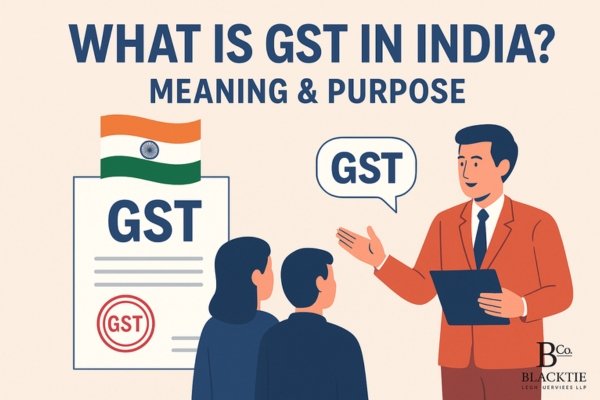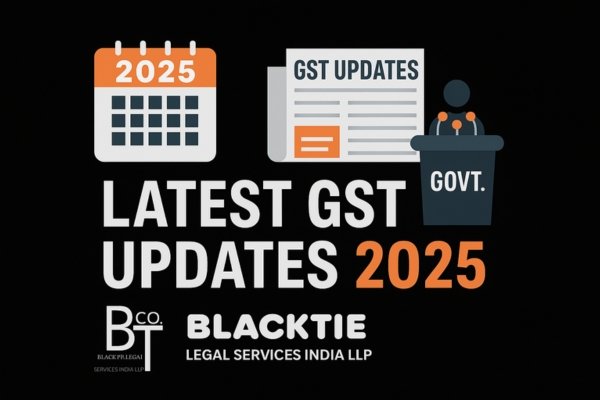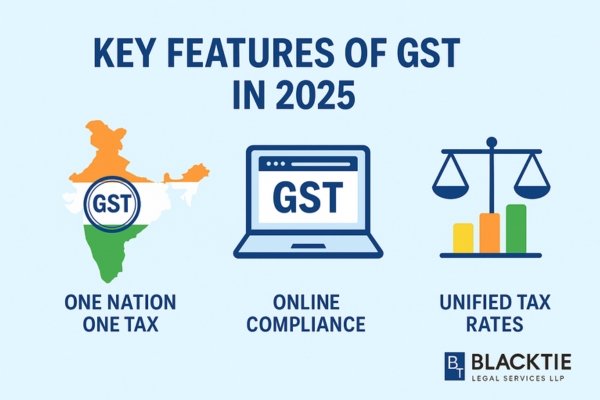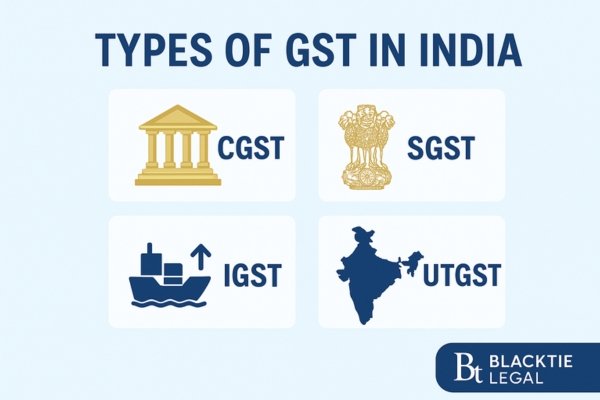
For Applying GST Registration Click Here…
What is GST in India?
✅ Meaning of Goods and Services Tax
GST in India (Goods and Services Tax) is a unified indirect tax that applies to the supply of goods and services across the country. Instead of paying multiple taxes like VAT, service tax, and excise duty, businesses and individuals now pay a single tax under GST, making the tax system more transparent and efficient.
✅ Why GST Was Introduced
Before GST, India had a complex tax structure with multiple state and central taxes, leading to double taxation and a compliance burden. To simplify this, the government introduced GST on 1st July 2017. The aim was to:
- Create a “One Nation, One Tax” system
- Reduce cascading of taxes (tax on tax)
- Improve compliance through digital filing.
- Boost the ease of doing business for small and large enterprises

Latest Updates in GST Process 2025
1. Recent Amendments & Major Reforms
- GST 2.0 / Rate Rationalisation
The GST Council has introduced a simplified slab structure, effective 22nd September 2025. The old multiple slabs (5%, 12%, 18%, 28%) have been rationalised into primarily three slabs: 5%, 18%, and a new 40% “de-merit / luxury/sin goods rate. Press Information Bureau+7india-briefing.com+7Kotak Mutual Fund+7 - Goods & Services Rate Changes for Common Items
Many essential items—daily-use food products, packaged goods, toiletries, etc.—will see GST reduced (e.g. from 12% or 18% down to 5%) under the revised slabs. Luxury items, sin goods are being taxed more heavily. www.bajajfinserv.in+3The Economic Times+3india-briefing.com+3 - Simplification in Refunds & Inverted Duty Structure
The government is making changes to improve how refunds work—especially in cases of inverted duty structure (where input tax is higher than output tax). From 1 November 2025, there will be a provision for provisional sanction of 90% of the refund amount in such cases. Goods and Services Tax Council - Simplified / Automated GST Registration for Low-Risk Businesses
Starting 1 November 2025, a more streamlined or simplified registration scheme will be available for low-risk applicants. If their expected output tax liability is under a certain threshold (roughly ₹2.5 lakh per month), the registration may be granted automatically within three working days. Goods and Services Tax Council - Changes to Place of Supply Rules (for Intermediary Services)
The GST Council is planning to amend section 13(8) of the IGST Act to change how “intermediary services” are treated—so the place of supply will follow the default rule (recipient location) rather than a special clause. This helps Indian exporters of services. Goods and Services Tax Council - Post-Sale Discount Rules
Amendments are being made to sections dealing with discounts after a sale. The requirement that discounts must be pre-agreed and linked to specific invoices is being relaxed; a credit note under section 34 will be sufficient. This helps in flexibility for businesses. Goods and Services Tax Council
2. Government Announcements & Other Key Developments
- Manufacturers Revising MRP for Unsold Stock
Because of the rate changes, manufacturers, packers, and importers are now allowed to revise the MRP (maximum retail price) of unsold stock using stickers, stamping, etc., until 31 December 2025 or until the stock is exhausted. The Economic Times - Transparency & Consumer Relief Measures
Authorities are pushing for more transparency: businesses are asked to display both pre-GST and post-GST prices of goods (especially consumer durables and cars) so consumers can see how much GST relief they are getting. The Economic Times - Changes in GSTR-7 & GSTR-8 Formats
From February 2025, the formats for GSTR-7 (for deductors) and GSTR-8 (for e-commerce platforms collecting TCS) have been updated to require more detailed, invoice-level / document-level data. This is to improve reconciliation and reduce mismatches. IndiaFilings
✅ What This Means for Freelancers / Small Businesses
- If you’re a freelancer or small business, many of these changes aim to reduce compliance friction (e.g. simpler slabs, automatic registration for low-risk cases).
- But you’ll need to update your invoices, invoice reporting, and accounting systems to align with the new slabs, the changed categories, and new refund/discount rules.
- Be alert to the timelines: e.g., 22nd September 2025 for rate changes, 1 November 2025 for new provisions, etc. Missing dates can lead to confusion or compliance issues.
If you like, I can pull together a summary table of these updates (what changes, when they’re effective, what to do as a freelancer) so your readers get a quick snapshot. Do you want that?
Latest GST‑Process News

Key Features of the GST Process in 2025
Over the years, the Goods and Services Tax has evolved to become more simplified and technology-driven. Here are the major features of GST in India in 2025:
✅ One Nation, One Tax
GST has successfully replaced multiple indirect taxes with a single, unified tax system. Whether you are a small business, freelancer, or large corporation, GST ensures uniformity in taxation across all states.
✅ Online Compliance System
The GST framework is completely digital—from registration to return filing and payments. In 2025, with enhanced features on the GST portal, taxpayers can file returns, track refunds, and manage compliance with greater ease.
✅ Unified Tax Rates
GST provides a standardised rate structure across goods and services. By eliminating the cascading effect of multiple taxes, it has made pricing more transparent and predictable for both businesses and consumers.

Types of GST in India
To create a fair and balanced tax system, GST is divided into different categories depending on whether a transaction is made within a state or across states. Here are the main types of GST in India:
✅ CGST (Central Goods and Services Tax)
CGST is the tax collected by the Central Government on transactions happening within a state. For example, if you provide a service to a client in your own state, part of the GST charged will go to the Centre as CGST.
✅ SGST (State Goods and Services Tax)
SGST is the tax collected by the State Government on the same intra-state transaction. It runs parallel to CGST, and both are applied together. For instance, if you issue a bill in your state, GST is divided between CGST and SGST.
✅ IGST (Integrated Goods and Services Tax)
IGST is applied on inter-state transactions, meaning when goods or services are supplied from one state to another. The Central Government collects IGST and later distributes the share to respective states.
✅ UTGST (Union Territory Goods and Services Tax)
UTGST applies to supplies made in Union Territories like Delhi, Chandigarh, Lakshadweep, Andaman & Nicobar Islands, etc. It works similarly to SGST but is specifically for union territories.
GST Registration Process 2025
If you are running a business, freelancing, or providing taxable services, it’s important to understand the GST registration process in 2025. The entire procedure is online, making it easier and faster for taxpayers to get registered.
✅ Who Needs GST Registration?
GST registration is mandatory for:
- Businesses and freelancers with an annual turnover above ₹20 lakh (₹10 lakh in special category states).
- Service providers working with clients across states or outside India.
- E-commerce sellers and businesses are required to collect TCS.
- Individuals or businesses opting for voluntary registration to avail benefits like input tax credit and business credibility.
✅ Documents Required for GST Registration
To complete the GST registration process 2025, the following documents are generally needed:
- PAN card and Aadhaar card of the applicant
- Bank account proof (cancelled cheque, bank statement, or passbook copy)
- Business address proof (rent agreement, electricity bill, or ownership papers)
- Photograph of the applicant
- Digital signature (DSC) in case of companies and LLPs
✅ Online Registration Steps
The GST registration process in 2025 is fully digital and can be completed on the GST portal:
- Visit the GST portal and click on “New Registration.”
- Fill Part A with PAN, mobile number, and email ID. Verify using OTP.
- Fill Part B with business details and upload the required documents.
- Apply and receive the Application Reference Number (ARN) for tracking.
- After verification, the GST department will issue a GSTIN (Goods and Services Tax Identification Number).
GST Invoice Process 2025
Issuing the correct invoice is an important part of compliance under GST. The GST invoice process 2025 ensures transparency in transactions and helps both businesses and clients claim input tax credit (ITC).
✅ Mandatory Details in GST Invoices
Every GST invoice must include specific details to be valid under the law. These include:
- Name, address, and GSTIN of the supplier
- Name, address, and GSTIN of the recipient (if registered)
- Invoice number and date
- Description of goods or services supplied
- HSN/SAC code of the goods or services
- Quantity and unit (for goods)
- Taxable value, rate of GST, and amount of tax (CGST, SGST, IGST, UTGST)
- Place of supply (especially for inter-state transactions)
- Signature or digital signature of the supplier
Without these mandatory details, an invoice may be considered invalid for GST purposes.
✅ E-Invoicing System
In 2025, the e-invoicing system under GST has become more streamlined. Businesses with a turnover above the prescribed threshold must generate invoices through the government’s Invoice Registration Portal (IRP). Once uploaded, each invoice is assigned a unique Invoice Reference Number (IRN) and a QR code.
Benefits of e-invoicing:
- Prevents fake or duplicate invoices
- Ensures real-time reporting of transactions
- Simplifies GST return filing since invoice data is auto-populated
- Helps buyers easily claim input tax credit
GST Payment Process 2025
After filing returns, taxpayers must settle their GST liability on time to avoid penalties. The GST payment process 2025 is straightforward and can be done online or offline.
✅ How to Calculate GST Liability
Freelancers and businesses can calculate GST liability using this formula:
GST Liability = Output GST – Input Tax Credit (ITC)
- Output GST → Tax collected from clients/customers on sales or services.
- Input Tax Credit (ITC) → Tax already paid on business-related purchases.
👉 Example: If a freelancer charges ₹18,000 GST on services and has paid ₹5,000 GST on software/tools, then the net liability = ₹18,000 – ₹5,000 = ₹13,000.
✅ Modes of GST Payment (Online & Offline)
- Online Payment (Preferred in 2025)
- Through the GST portal (www.gst.gov.in)
- Modes available:
- Internet Banking
- Debit/Credit Cards
- UPI
- NEFT/RTGS
- Internet Banking
- Through the GST portal (www.gst.gov.in)
- Offline Payment
- Generate a challan from the GST portal.
- Visit an authorised bank and deposit the amount in cash, cheque, or demand draft.
- Generate a challan from the GST portal.
💡 Note: For freelancers and small businesses, online payment is the fastest and most convenient option since challan and payment status are auto-updated in the GST system.
GST Return Filing Process 2025
GST return filing is a mandatory compliance requirement for every GST-registered business and freelancer. It involves reporting sales, purchases, tax collected, and tax paid within specified timelines. The GST system in 2025 continues to focus on digital filing through the GST portal (www.gst.gov.in).
✅ Types of GST Returns
- GSTR-1 (Sales/Outward Supplies)
- Contains details of invoices raised for services/products.
- Frequency: Monthly/Quarterly, depending on turnover.
- Due date:
- Monthly filers → 11th of the next month
- Quarterly filers (QRMP scheme) → 13th of the month following the quarter
- Monthly filers → 11th of the next month
- Contains details of invoices raised for services/products.
- GSTR-3B (Summary Return)
- Summary of sales, purchases, GST liability, and ITC.
- Filed monthly by all taxpayers.
- Due date: 20th of the next month
- Summary of sales, purchases, GST liability, and ITC.
- GSTR-9 (Annual Return)
- Consolidated return for the entire financial year.
- Mandatory for businesses/freelancers with a turnover above ₹2 crore.
- Due date: 31st December of the following financial year
- Consolidated return for the entire financial year.
✅ Filing Frequency (Monthly, Quarterly, Annual)
- Monthly → For businesses/freelancers with turnover above ₹5 crore.
- Quarterly (QRMP scheme) → For those with turnover up to ₹5 crore.
- Annual → GSTR-9 for larger taxpayers, consolidating the year’s GST filings.
✅ Due Dates and Penalties
- Late Fee for GSTR-1 & GSTR-3B:
- ₹50 per day (₹25 CGST + ₹25 SGST)
- ₹20 per day (₹10 CGST + ₹10 SGST) for nil returns
- ₹50 per day (₹25 CGST + ₹25 SGST)
- Interest on Late Payment:
- 18% per annum on outstanding tax liability
- 18% per annum on outstanding tax liability
- Annual Return Penalty (GSTR-9):
- ₹200 per day (₹100 CGST + ₹100 SGST) subject to a maximum of 0.25% of annual turnover
GST Input Tax Credit (ITC) Process
The Input Tax Credit (ITC) under GST is one of the biggest advantages of the GST system in India. It ensures that businesses and freelancers don’t have to pay tax multiple times on the same value addition.
✅ What is ITC and How It Works?
- Input Tax Credit (ITC) means you can reduce the GST you pay on sales (output tax liability) with the GST you have already paid on purchases (input tax).
- Simply put, ITC ensures that tax is levied only on the value addition, preventing the cascading effect of “tax on tax.”
🔹 Example:
- A freelancer buys a laptop for ₹50,000 + 18% GST (₹9,000).
- Later, the freelancer provides services worth ₹1,00,000 + 18% GST (₹18,000).
- While paying tax, the freelancer can claim the ITC of ₹9,000 already paid on the laptop.
- Final tax payable = ₹18,000 – ₹9,000 = ₹9,000 only.
✅ Conditions to Claim ITC
To avail ITC under GST, the following conditions must be met:
- Valid Tax Invoice or Debit Note
- You must have a GST-compliant invoice from a registered supplier.
- You must have a GST-compliant invoice from a registered supplier.
- Receipt of Goods or Services
- The goods/services must be received to claim ITC.
- The goods/services must be received to claim ITC.
- GST Payment by Supplier
- The supplier must have paid the tax collected to the government.
- The supplier must have paid the tax collected to the government.
- GST Return Filing
- The buyer (you) must file GST returns regularly to claim ITC.
- The buyer (you) must file GST returns regularly to claim ITC.
- Payment to Supplier
- Payment must be made to the supplier within 180 days of invoice issuance.
- Payment must be made to the supplier within 180 days of invoice issuance.
- Blocked Credits (Not Eligible for ITC)
- Personal use items (e.g., personal car, food & beverages, club memberships).
- Goods/services used for exempt supplies.
- Works contract services for construction (except when used for further supply).
- Personal use items (e.g., personal car, food & beverages, club memberships).
GST Compliance Requirements in 2025
Staying compliant under GST is not just about paying taxes on time — it also involves proper documentation, reconciliation, and reporting. With digital systems becoming stricter in 2025, businesses and freelancers must follow these key compliance requirements:
✅ E-way Bill Compliance
- An E-way bill is mandatory for the movement of goods worth more than ₹50,000 across states or within a state.
- It is generated online on the GST E-way bill portal and must contain details like invoice number, value of goods, transporter details, and GSTIN.
- Failure to carry an E-way bill can result in penalties, confiscation of goods, or seizure of the vehicle.
✅ GST Reconciliation
- GST reconciliation means matching your sales and purchase data with the details uploaded by your suppliers on the GST portal.
- It ensures that the Input Tax Credit (ITC) claimed is correct and not reversed due to mismatches.
- In 2025, automated reconciliation tools in the GST portal make this process easier, but regular cross-checking is still essential.
✅ Audit and Annual Return Filing
- Businesses with a turnover above ₹2 crore must file an annual GST return (GSTR-9).
- For larger taxpayers (turnover above ₹5 crore), a GST audit may also be required, including certification by a Chartered Accountant or Cost Accountant.
- Annual returns provide a consolidated view of sales, purchases, ITC claimed, and taxes paid for the year.
- Missing deadlines can lead to heavy penalties and loss of ITC benefits.
Penalties for Non-Compliance in the GST Process
Non-compliance with GST rules can lead to financial losses, penalties, and even legal consequences. The government has set strict guidelines to ensure taxpayers file returns and pay taxes on time.
✅ Late Fees and Interest
- Late Fees:
- ₹50 per day (₹25 CGST + ₹25 SGST) for delayed return filing.
- ₹20 per day (₹10 CGST + ₹10 SGST) for Nil returns.
- Capped at a maximum of ₹5,000 per return.
- ₹50 per day (₹25 CGST + ₹25 SGST) for delayed return filing.
- Interest:
- 18% per annum on the outstanding tax liability (calculated from the due date till the actual payment date).
- 24% per annum may apply in case of excess ITC claims or wrong utilisation.
- 18% per annum on the outstanding tax liability (calculated from the due date till the actual payment date).
✅ Legal Actions
- Non-filing of GST Returns may result in suspension or cancellation of GST registration.
- Fraudulent activities like issuing fake invoices, underreporting turnover, or wrong ITC claims can lead to:
- Penalties up to 100% of the tax evaded.
- Prosecution with fines and imprisonment in severe cases.
- Penalties up to 100% of the tax evaded.
- Repeated non-compliance can also restrict businesses from claiming Input Tax Credit and working with corporate clients.
Conclusion – Why Understanding the GST Process is Important in 2025
The GST Process 2025 has become more streamlined, digital, and compliance-driven than ever before. From registration and invoicing to return filing, ITC claims, and audits, every step is designed to create a transparent tax system that benefits both businesses and the government.
For freelancers, startups, and established companies, understanding GST is not just about avoiding penalties — it’s about gaining legal recognition, optimising tax liability, and building trust with clients. With the latest reforms and rate rationalisation, the system is moving closer to the vision of “One Nation, One Tax” while reducing the cascading effect of taxes.
In short, knowing the GST process helps you:
- Stay legally compliant
- Claim rightful input tax credit.
- Improve business credibility
- Avoid unnecessary costs and penalties.
✨ Whether you are a freelancer, small business owner, or large enterprise, a clear understanding of the GST process in 2025 is essential for smooth operations and sustainable growth.
FAQs
What is the GST in India?
GST (Goods and Services Tax) is a unified indirect tax that replaces multiple state and central taxes. It ensures “One Nation, One Tax” by levying tax only on value addition.
Who needs to register for GST in 2025?
Any business or freelancer with an annual turnover above ₹20 lakh (₹10 lakh for North-Eastern states) must register. Voluntary registration is also allowed for those who want to claim ITC or work with corporate clients.
What are the types of GST in India?
CGST – Central Goods and Services Tax
SGST – State Goods and Services Tax
IGST – Integrated Goods and Services Tax (for inter-state supplies)
UTGST – Union Territory Goods and Services Tax
How can I register for GST online in 2025?
You can register through the official GST portal (www.gst.gov.in) by filling Form GST REG-01, uploading required documents, and completing Aadhaar-based verification. Once approved, you’ll get a GSTIN (GST Identification Number).
What is GSTIN?
GSTIN (Goods and Services Tax Identification Number) is a unique 15-digit number provided after successful GST registration. It must be quoted on invoices and returns.
How do I file GST returns in 2025?
GSTR-1 → Monthly/Quarterly sales return
GSTR-3B → Monthly summary return
GSTR-9 → Annual return (mandatory for businesses above ₹2 crore turnover)
Returns are filed online via the GST portal.
What happens if I don’t comply with GST rules?
Non-compliance leads to late fees, interest, and legal actions. Returns not filed on time can also cause suspension or cancellation of GST registration.
Can freelancers claim Input Tax Credit (ITC)?
Yes. If registered under GST, freelancers can claim ITC on expenses like software subscriptions, equipment purchases, and business-related services, provided they have valid GST invoices.
Are GST rates the same for all services in 2025?
Generally, services are taxed at 18%, but some special categories (IT, education, healthcare, transport) may have different rates based on government notifications.
What are the latest GST updates in 2025?
The government has simplified slabs (5%, 18%, 40%), allowed automatic registration for low-risk businesses, and introduced refund reforms to make compliance easier.
